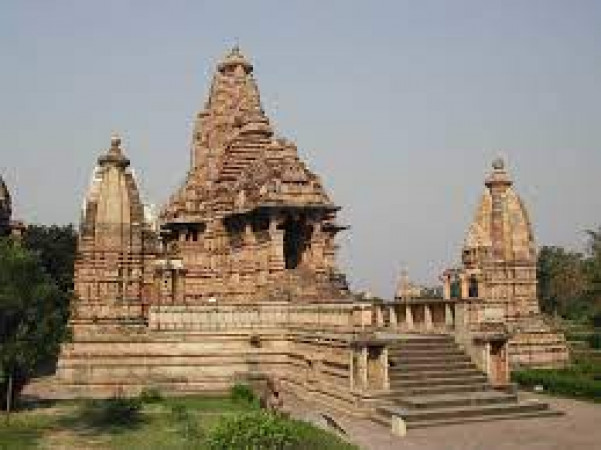Laxman Temple Travel Guide
Located in Khajuraho, India, Laxman Temple is a renowned UNESCO World Heritage Site known for its stunning architecture and intricate carvings. Built in the 10th century, this temple is dedicated to Lord Vishnu and showcases the rich cultural heritage of India. The temple holds great historical significance and is a testament to the artistic brilliance of ancient Indian craftsmen. Laxman Temple attracts tourists from all over the world who are fascinated by its beauty and historical importance.Top Attractions in Laxman Temple
- Exquisite stone carvings depicting mythological stories
- Impressive architecture with intricate details
- Sacred atmosphere perfect for spiritual seekers
- Light and sound show depicting the history of the temple
- Surrounding temples showcasing the Chandela dynasty's architectural prowess
Laxman Temple is Famous for
Its exquisite stone carvings and impressive architecture.Top Attractions in Laxman Temple
- Exquisite stone carvings depicting mythological stories
- Impressive architecture with intricate details
- Sacred atmosphere perfect for spiritual seekers
- Light and sound show depicting the history of the temple
- Surrounding temples showcasing the Chandela dynasty's architectural prowess
What's Great about Travelling to Laxman Temple?
- Perfect for history and architecture enthusiasts
- Spiritually enriching experience for religious travelers
- Unique cultural insights into ancient Indian craftsmanship
What's Not So Great about Travelling to Laxman Temple?
- May not be suitable for travelers seeking modern attractions
- Limited dining and accommodation options
- Hot and humid weather during certain months
Travel Tips for Laxman Temple
- Carry sufficient water and sun protection
- Respect the temple's sanctity and dress modestly
- Check for any religious or cultural events happening during your visit
Important Laxman Temple trip information
- Ideal Duration: 1-2 days
- Best Time to Visit: October to March
- Nearby Airports and Railway Stations: Khajuraho Airport and Khajuraho Railway Station
FAQ's on Laxman Temple
Q1: What is the best time to visit Laxman Temple?
The best time to visit Laxman Temple is during the winter months from October to March when the weather is pleasant and ideal for exploring the temple complex. This period also coincides with the festive season, offering a chance to witness local celebrations and events. Summer months from April to June can be hot, while the monsoon season from July to September brings heavy rainfall which may affect travel plans.
Q2: Do I need a visa to travel to Laxman Temple?
Most visitors to Laxman Temple will need a tourist visa to enter the country. It is recommended to check the specific visa requirements based on your nationality before planning your trip. Some countries may be eligible for visa-on-arrival or e-visa facilities, but it is advisable to confirm this information with the local embassy or consulate.
Q3: What are the must-visit attractions in Laxman Temple?
Laxman Temple is known for its iconic temple complex, intricate carvings, and historical significance. Must-visit attractions include the main temple dedicated to Lord Vishnu, the Kandariya Mahadev Temple, Devi Jagadambi Temple, and the Varaha Temple. Visitors should also explore the Matangeshwar Temple, Chitragupta Temple, and the Lakshmana Temple to fully experience the architectural beauty and spiritual essence of the region.
Q4: Is Laxman Temple a safe place to travel?
Laxman Temple is generally a safe destination for travelers. However, like any tourist spot, it is advisable to take standard precautions such as safeguarding your belongings, avoiding isolated areas after dark, and staying alert in crowded places. It is recommended to respect local customs and traditions to ensure a smooth and enjoyable travel experience.
Q5: What is the local currency in Laxman Temple and can I use credit cards?
The local currency in Laxman Temple is the Indian Rupee (INR). It is advisable to carry sufficient cash as credit card acceptance may be limited, especially in smaller establishments. ATMs are available in nearby towns for convenient access to cash. It is recommended to inform your bank about your travel plans to avoid any issues with card usage.
Q6: What is the local cuisine like in Laxman Temple?
The local cuisine in Laxman Temple offers a mix of traditional Indian flavors and regional specialties. Visitors can savor delicious dishes such as Poha, Dal Bafla, Bhutte Ki Kees, and traditional sweets like Malpua and Jalebi. Vegetarian options are prevalent in the region, reflecting the cultural preferences. Travelers with dietary restrictions can easily find options like gluten-free or vegan meals in restaurants and eateries around the temple complex.
Q7: What transportation options are available in Laxman Temple?
Transportation options in Laxman Temple include local buses, auto-rickshaws, and taxis for getting around the temple complex and nearby areas. Hiring a private car or taxi for a day tour is a popular choice for exploring the various temples and attractions at your own pace. Bicycle rentals are also available for those who prefer to explore the region on two wheels. It is advisable to negotiate fares with auto-rickshaw drivers and taxi services before starting your journey.
Q8: Are there any cultural norms or etiquette I should be aware of when visiting Laxman Temple?
When visiting Laxman Temple, it is important to respect local customs and etiquette. Modest clothing is recommended when visiting religious sites, and it is customary to remove footwear before entering temples. Visitors should refrain from public displays of affection and adhere to photography restrictions in certain areas. Greeting locals with a polite "Namaste" is appreciated, and it is advisable to ask for permission before taking photographs of individuals. Learning about the cultural significance of the temples and engaging with local guides can enrich your experience and show respect for the heritage of the region.
Q9: I am a travel agent. How can I buy travel leads of Laxman Temple?
Register yourself as a travel agent at agents.tripclap.com and then you can buy travel leads to Laxman Temple once your account is approved. For more details contact our support team at +91-8069186564 or support@tripclap.com

